#Fossil Tooth Collection
Explore tagged Tumblr posts
Photo

RARE Miocene Ray Tooth Fossil | S'Algar, Menorca | Authentic Prehistoric Marine Specimen | Certified Fossil | Collectible Fossilized Tooth
Discover a Rare Ray Tooth Fossil from the Miocene epoch, unearthed in S'Algar, Menorca. This beautifully preserved fossil offers a glimpse into the marine life that thrived around 15 million years ago. Menorca’s fossil-rich formations provide some of the finest examples of prehistoric marine life, making this an exceptional addition to any fossil collection.
Rays, known for their cartilaginous skeletons and specialized dental plates, used their teeth to crush and grind shellfish and crustaceans. This rare specimen highlights the intricate details of the tooth structure, making it a valuable educational and display piece.
Fossil Information:
Species: Prehistoric Ray (Exact species undetermined)
Fossil Type: Single Tooth
Geological Formation: Miocene Deposits
Age: ~15 million years old (Miocene Epoch)
Location: S'Algar, Menorca
Size: Full sizing provided in photos (Scale: 1cm per square)
Preservation: Excellent, showing distinct dental features
Key Features:
✔ Authentic Miocene Ray Tooth Fossil
✔ Sourced from the fossil-rich region of Menorca
✔ Well-preserved with natural dental structures
✔ Ideal for collectors, museum displays, and educational use
Authenticity & Certification:
All of our fossils are 100% genuine specimens and come with a Certificate of Authenticity. The fossil shown in the photos is the exact specimen you will receive.
Why Buy From Us?
This Ray Tooth fossil comes from the prestigious Alice Purnell Collection, one of the largest and most respected fossil collections in the world. We specialize in high-quality, museum-grade fossils, ideal for serious collectors, educators, and researchers.
🦈 Own a rare piece of Miocene marine history today—add this Ray Tooth fossil to your collection!
#Ray Tooth Fossil#Miocene Fossil#Menorca Fossil#Prehistoric Marine Fossil#Fossilized Ray Tooth#Certified Fossil#Authentic Fossil#Fossil Collector Item#Marine Life Fossil#Fossil Tooth Collection#Fossil from Spain#Fossil Gift#Rare Fossils for Sale#Shark and Ray Fossils#Miocene Marine Fossil
0 notes
Text
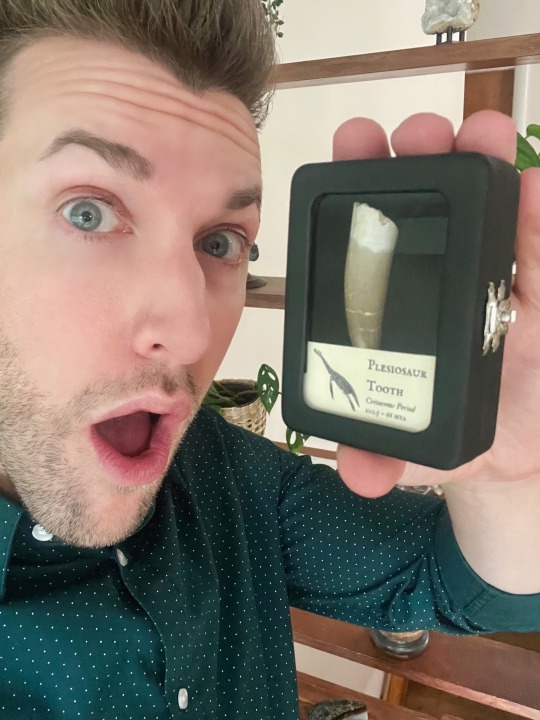

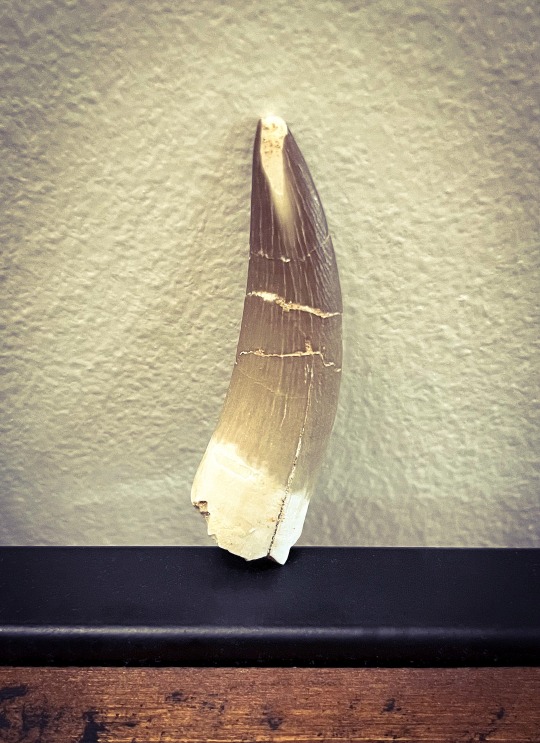
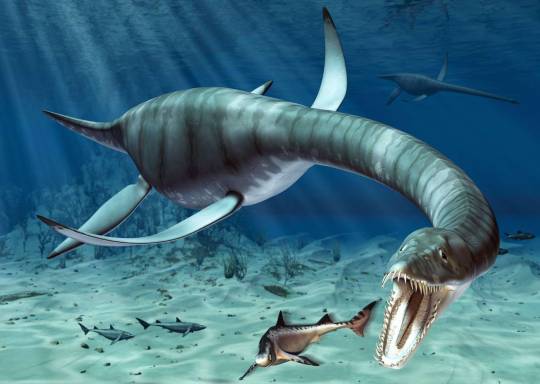
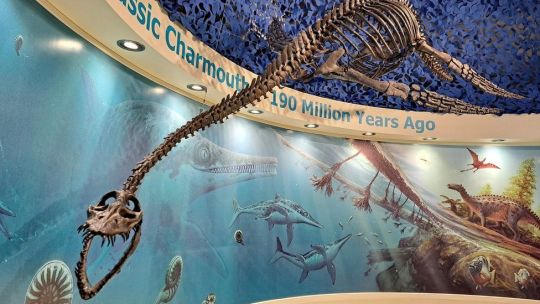

Just added another super cool fossil to the collection! This genuine Plesiosaur tooth was found in Morocco and dates all the way back to the Cretaceous period. It’s also quite a large specimen, measuring almost 2.5” in length!
Plesiosaurs are often mistaken for dinosaurs, however these prehistoric creatures are actually part of a separate group known as "marine reptiles." They first evolved in the Triassic (208.5 MYA) and thrived until the massive KT extinction event caused by the Chicxulub asteroid. This took place at the end of the Cretaceous, and was the same extinction event that wiped out the non-avian dinosaurs (66 MYA). 💥🌊
#collecting#collection#collectibles#collector#dinosaurs#dinosaur#dino#dinos#plesiosaur#loch ness monster#nessie#marine reptile#tooth#fossil#fossils#prehistoric#when dinosaurs ruled the earth#paleontology
90 notes
·
View notes
Text

All fossil charm necklace and charm bracelet! Currently making stock for the upcoming Columbus oddities and curiosities expo (4/20 and 4/21 2024) but if you'd like me to list this one online instead or if you'd like a custom one any time message me!
#fossil collection#fossils#fossil#collection#collecting#ammonite#belemnite#shark tooth#gastropod#bivalve#trilobite#oddities#charm bracelet#charm necklace#wire wrap#handmade jewelry
9 notes
·
View notes
Text
I have Dino brain so I asked my gf what her favorite dinosaur was and she said the only one she knows are T-Rex, Pterodactyl and palentosaurus which sounds real except she was definitely thinking that a paleontologist was a dinosaur and not an actual living person 🧍♀️
I’m just going to play my silly little dino game since she doesn’t want to talk dino with me
#irl gf#she supports me tho#got me a spinosaur tooth which is cool as hell#she remembered spino is a Dino and that I like them just long enough lol#my little baby fossil and rock collection
0 notes
Text
.
0 notes
Text
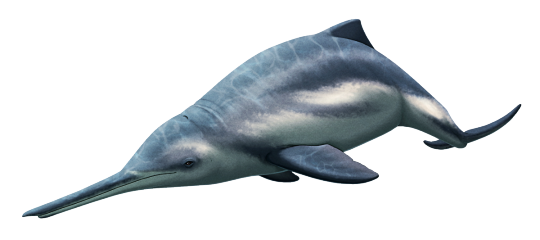
Romaleodelphis pollerspoecki was a dolphin-like toothed whale related to the ancestors of both modern oceanic dolphins and beaked whales, living in coastal waters covering what is now Austria during the early Miocene about 22 million years ago.
Although only known from a single fossil skull, this cetacean was probably around 3m long (~9'10"). It had a long snout lined with over 100 small pointed uniformly-shaped teeth, and the bony walls of its inner ears were well-preserved enough to show that it was able to hear narrow-band high frequency sounds – a specific form of echolocation that has convergently evolved multiple times in various modern and extinct toothed whale lineages.
Based on the presence of ancient river-mouth deposits in the area where Romaleodelphis was found, it may potentially have been capable of traversing between marine, brackish, and freshwater environments similar to the modern franciscana.
———
NixIllustration.com | Tumblr | Patreon
References:
Bavarian State Collections of Natural History. "'Astonishing Results' – Scientists Reveal Secrets of Mysterious 22-Million-Year-Old Dolphin Skull." SciTechDaily, 15 Nov. 2024, https://scitechdaily.com/astonishing-results-scientists-reveal-secrets-of-mysterious-22-million-year-old-dolphin-skull/
Sanchez-Posada, Catalina, et al. "Romaleodelphis pollerspoecki, gen. et sp. nov., an archaic dolphin from the Central Paratethys (Early Miocene, Austria)." Journal of Vertebrate Paleontology (2024): e2401503. https://doi.org/10.1080/02724634.2024.2401503
Wikipedia contributors. “Romaleodelphis” Wikipedia, 06 Nov. 2024, https://en.wikipedia.org/wiki/Romaleodelphis
#science illustration#paleontology#paleoart#palaeoblr#romaleodelphis#odontoceti#toothed whale#cetacean#whale#artiodactyla#ungulate#mammal#art#marine mammals
378 notes
·
View notes
Note
lemme see ur fossil bivalves pls ily



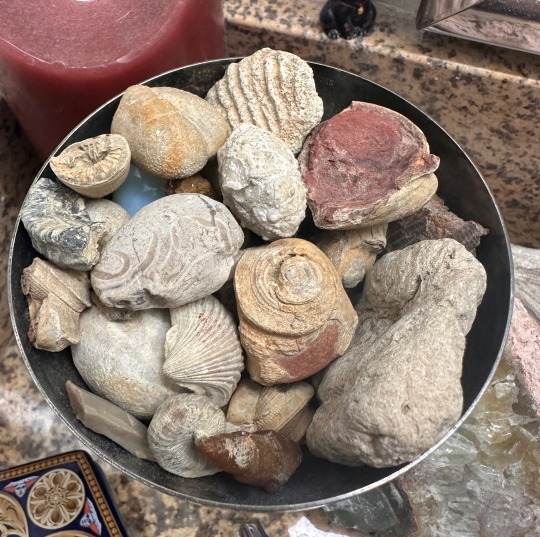

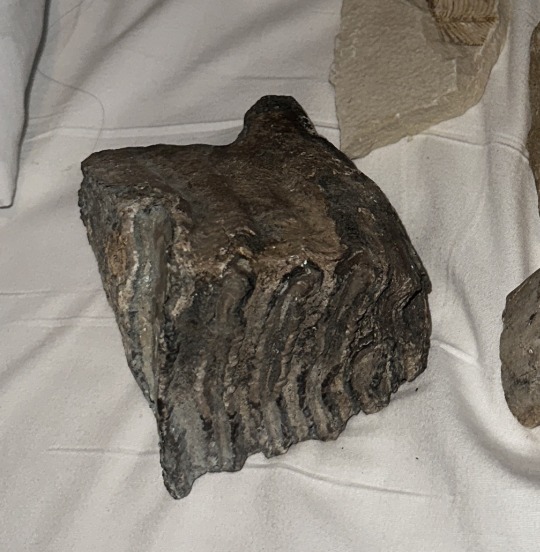
the specific bivalves i was talking about are not available atm (they are in place to freak ppl out) BUT here’s a few pics of my other little fossils!!
1st pic: dug these out of the upper cook mountain formation in south texas myself recently !!
2nd/3rd: mazon creek concretion i got to crack open myself. was very fun!! (i have another cracked one somewhere too, and one also currently in the freezer undergoing an artificial freeze thaw process)
4th: my lil chalice of fossils. mostly from central tx (a few very well preserved echinoids, bivalves, porocystis globularis, gastropods, coral, and ammonite pieces !!)
5th: a pretty well-preserved ammonite i got from a collections lab freebie pile :3
6th: partial mammoth tooth from new mexico!!! i used it as a doorstop sometimes but that felt rude
#talk#ask#i do have pics of some of the bivalves but not the ones suited for nefarious purposes#i pried them out of the side of the river bank when tubing w friends last summer haha !!!
91 notes
·
View notes
Text
Treasures {Bachira Meguru x Reader}
Small gifts between you and Meguru throughout the years
Childhood friends to lovers, fluff, not kidding this is sickeningly sweet, gender neutral reader, inspired by that additional time where bachira has a bunch of little objects/junk he calls his treasures because i do that too and i thought it was cute. word count: 3100 | Ao3 version

Your friendship with Bachira Meguru began when he pressed a beaten-up plastic dinosaur figure into your hands.
To him, it started a bit earlier, when you became the first person to ever stand up to his childhood bullies. They had started with the normal taunts, calling Meguru a freak and a weirdo, before they started pushing him around. He was just about to headbutt one of them when a tiny shoe came flying through the air just to hit one of the bullies on the head with startling accuracy. The shoe hit before he even heard your own squeaky voice calling his tormentors meanies as you half-ran half-hobbled over with only one sandal on.
The bullies scattered, one nursing his sore head, and Meguru got his first look at his savior. He was instantly entranced by you, and he knew he had to become your friend. You were just so cool! (His opinion would not be shaken, even when you tripped over your own feet soon afterwards before you could retrieve your makeshift projectile.)
He knew he had to do something to repay you, something to cement his offer of friendship. And so, (after you had gotten up and scrubbed the dirt from your face), he retrieved the grubby sauropod from his pocket and presented it to you like it was a tribute to an ancient god.
The two of you were both snotty-nosed toddlers, so, to you, this was equivalent to a blood pact of loyalty. He had found the toy on the ground, covered in dirt and with its tail halfway chewed off; to him, it was a precious treasure, a discovery akin to digging out a real fossilized dinosaur skeleton. He gave it to you, stating that the color of dinosaur’s molded-plastic skin reminded him of your eyes, and he would like to be your friend very much since you were so cool.
You received the toy with the appropriate sounds of amazement. Then, you gave him a gap-toothed smile before pulling him over to the swing set, giggling about how you bet you could swing higher than your new friend.
(You couldn’t, if only because Meguru went up so high he slipped off of the swing completely and was left dangling by his arms as you screeched.)
—
It became somewhat of a tradition for you both to exchange little trinkets you had discovered.
Meguru was constantly picking things up off of the ground and sticking them in his pockets. He called them his treasures, and they ranged from acorns to cool rocks to coins to beads, whatever little bauble caught his eye. You picked up the habit from him, though it took little coaxing; you had barely known him for a week before you were presenting him with corroded pennies and half-smashed nuts that he oohed and aahed over appreciatively.
You had a special shelf at home that you collected Meguru’s gifted treasures on. It sent a little bolt of happiness through your chest every time you looked at them; somehow, even after all this time, Meguru gifting you something had not lost its spark. Each time he presented you with a new find, proclaiming how it had made him think of you, you felt giddier and giddier.
It was a feeling only matched by the excitement of him accepting one of your presents. His whole being reminded you of the sun, from is cheery demeanor to his golden eyes, but his smiles were brighter than sunshine in your eyes; he lit up your entire life.
It was this smile you were rewarded with when you carefully attached your newest present to his school uniform lapel. It was a small dolphin pin, pristine except for a small chip in the blue enamel of its dorsal fin; a lucky find from the dusty corner of the conbini. It was more ‘valuable,’ in a monetary sense, than many of your other presents to him (though likely not by much), but if there was ever an occasion to give him something special, it was now.
You knew how hard he had worked to get into the same high school as you did. You didn’t know how to bring it up verbally. There were no words, really, to tell him how much his loyalty to you meant. If you had nothing and no one else in life, you knew that Meguru would be by your side, and the knowledge of this was one of the warmest comforts you had ever known. But you were young, and your tongue stuck to the roof of your mouth when you tried to tell him just how much he meant to you.
So instead, you straightened his jacket, and ruffled his hair until his eyes were crinkled and his cheeks were red with laughter. And when he slipped his hand into yours, to pull you towards the entrance of your new school, you squeezed his fingers back and tried not to get blinded by his answering grin.
—
The two of you had slowly drifted away from the graduation ceremony and were now lying slumped in a heap on the grass.
Meguru had already discarded his school jacket somewhere, glad to never have to wear the wretched thing again. His tie was wrapped around your head like a schoolboy's hachimaki. He was spinning a pen he had found somewhere between his fingers as he gazed up at the sky. He made sure to nudge you when he saw a cloud that was vaguely shaped like a pig.
“Look, it’s the principal!” he crowed.
You let out a snort worthy of the cloud’s animal patron. “We’re being haunted!”
“I thought someone had to be dead to haunt you?” Meguru said thoughtfully.
“Well, he’s so old and crusty he might as well be.”
The two of you dissolve into giggles.
When you stopped laughing, you found yourself nearly nose to nose with Meguru. His eyes were a perfect, luminous amber in the sun, and you could see the shadow of your own face reflected in them. If you leaned in any closer, you thought you could fall right into them. Unconsciously, you bent towards him, head tilting to one side; whether you would plunge into his eyes or collide with his lips first, you weren’t sure, but you knew would not feel bad about either.
The two of you stayed like that for an unknown amount of time, breathing each other’s air. The excitement of the day had faded into something slower, sweeter and gentler than the electric tingle of nerves that danced through your limbs that morning. You could count the blurry dots of the freckles that speckle his cheeks, could see every shade of warm gold and sunflower yellow that braid together in his irises. You couldn’t see his smile, but you knew it was there, as surely as you could feel the upturn of your own lips.
In the end, you didn’t drown in his eyes, nor did you touch his lips with yours; instead, he tapped his forehead against your forehead, like a cat, before pulling away. Your heart was filled with the same honey-warmth that lights up his eyes, because you knew that it wasn’t a rejection, but a promise. You had known him since you were small; nothing would ever tear Meguru from that special place in your heart, and you could guess from the way he clung to you that he felt the same. He had been yours for years, and vice versa. And the two of you would have each other for years to come. There was no rush now; now, there was only the slow, quieting warmth of a spring day and the promise of a life ahead.
Meguru passed you his pen, and you took it as the gift it was. The ink was a bright candy pink, and it blended in with the blush on Meguru’s cheeks as you drew bubblegum stars and constellations across the freckles of his face.
(Upon his forehead, you drew a small heart, right where you thought your skin kissed his.)
—
The air carried with it the unmistakable aftertaste of an oncoming storm.
Though the temperature outside was not unpleasant, the shoreline was empty aside from you and Meguru, the pale-gray sky having deterred any other potential beach-goers. Even though the beach was small, only touching a sliver of the ocean, and the weather would be called dismal at best…you were still excited. Everything about your new home excited you, because it was the home you now shared with Meguru.
The two of you never really talked about what you were to each other. It wasn't really necessary. You both knew, deep within your souls, that you were each other's most precious person. (You both knew that said souls were intertwined forever more.) Words couldn't express the affection you had for each other.
You both had been separated by distance for a long time as Meguru sparked his soccer career and you worked your way through college. You would call or message him whenever you were able, but it was…difficult, to go years where you would only be able to see his beautiful smile in person every few months. It was the sweetest of delights when you were finally able to live together again, this time in a home all your own.
Meguru had come here before you, by a few scant days, and had used the time not spent moving his things in to your new home exploring the area. And, out of all the places he had seen, the beach was the first place he wanted to show you.
You were still a little hazy from sleep, having passed out for far too long after your flight here (you almost wish you hadn't fallen asleep so quickly, so you could've reveled in Meguru's warm embrace for a little bit longer). But your happiness gave wings to your feet as Meguru dragged you by the hands into an improvised partner dance. Your shoes stuck awkwardly in the sand, kicking up damp grit with every movement, and the ocean breeze wreaked havoc on Meguru's fluffy hair. It wasn't the picturesque, beautiful thing of romance movies, but you thought it might be better; because it was real, but also because it was him.
His laughter echoed across the empty beach, cackling and unrestrained. The glint of his smile and the joy in his eyes would have outshone the sun, even if it were out in full force. The wind was cool but his hand was warm in yours; when he pulled you close, you could feel his heartbeat through his chest, thumping out of time with your footsteps. He spun the both of you around and around, until you got so dizzy and giggly you tripped over your own feet. Before you even registered your fall, you were caught around the waist by Meguru's surprisingly strong grip. He was bent forward over you, tips of his brown hair brushing your cheeks as he grinned down at you. You felt as if you couldn't breathe, frozen in place as your eyes meet his; there was so much love in his gaze as he looked at you, you felt struck dumb.
After a moment, he pulled you back upright, but not before he gave you the lightest kiss on the tip of your nose, complete with an over-exaggerated "mwah" sound. Your face felt like it was lit aflame, and you knew you were smiling like an idiot.
"Should have said you wanted to be dipped," Meguru cackled, before he was once more tugging you along by the hand.
He brought you over to a small pile of rocks at the end of the beach. After you stumbled over them, helped along by Meguru's tight grip on your wrist, you finally saw what he was so excited to show you.
In that sheltered corner of that small beach, hidden away, was a patch of sand that was absolutely covered in sea glass.
Even in the dim light, the multicolored glass pebbles gleamed against the dull sand. Polished by the waves and still glistening with water from the retreating tide, each oblong shape stood out like a tiny jewel. Just from what you could see on the beach's surface, there was umber, green, crystal clear, red, both pale and deep blue…each a sliver of beauty born of refuse, turmoil, and time.
"Ta dah!" Meguru said, gesturing his hands like he was showcasing a TV prize. "Rainbow beach!"
When you first came home to Meguru, he had given you a gift; a piece of sea glass, large enough to act as a paperweight. You realized that this must have been where he got it from. And now he was sharing that place with you.
Your cheeks hurt from how wide your smile stretched. You saw your excitement matched in his eyes, and you couldn't help but tug him into a quick, bone-crushing hug. "It's beautiful, Meguru. Thank you for showing me."
He's smug at your praise, like a cat that got the cream. You raced each other down to the secret kaleidoscopic beach, both rising to the unspoken challenge of seeking out the perfect piece of sea glass to give the other.
Scrabbling around in the grit of the sand, though perhaps not the most comfortable or dignified thing, made you feel young again. Meguru's presence made you feel young again, but only in the good ways; the world, all of a sudden, was something to be explored and felt and touched and enjoyed, rather than something to be endured, when he was with you. Your heart was light, and your face was open; both things that could sometimes be hard to accomplish these days. But you could always trust in Meguru to bring out the light in you.
You examined each piece of sea glass with a stringent eye. Most got tossed back; some were placed in your pocket as possible Meguru gift contenders, but none screamed out to you. Until.
You found it. The perfect one. The one that was meant for him.
Meguru was not observant enough to catch you this time as you tackled him. He was able to stop himself from collapsing fully onto his back, but the two of you went tumbling down all the same.
You found yourself naturally straddling his waist, bending partially over him as he leaned back, arms braced behind him. The fall had done nothing to wipe the perpetual catlike grin adorning his face away; even if it couldn't have felt good to be bowled over like that, he seemed nothing but thrilled to have you so close again.
His mouth had not even fully opened in question before you were presenting him with your latest treasure. "It matches your eyes," you said, voice softer than you intend and yet still not as soft as you feel inside.
Indeed, it did match his eyes; a perfect, deep shade of amber that drew you to it immediately. The glass was uniquely shaped; instead of a fully symmetrical rounded shape, it branched into two distinct lobes with a point at the other end, looking almost like a lopsided heart. It was perfect.
Meguru's eyes lit up. A hand came up to take his gift, holding it up close to his face to observe it. After a moment, he tucked it into the pocket of his shirt, right over his chest. The chesire-cat smile spread across his face softens at the edges, contentedly. "You always give me the best, don't you?"
It's so earnest. He couldn't just mean the gifts, you thought. His face was so open; those beautiful eyes that never left your mind were so wide you felt like you could look into the depths of Meguru's very being. His cheeks, brushed with freckles, were also dusted with the lightest of blushes. His hair was wind-swept and tangled, but it still looked to be the softest thing in the world.
You couldn't help yourself. Your hands reached up, cradling his face in your palms, thumbs pressing into the softness of those freckled cheeks. There was perfect understanding between the two of you, in that moment, born of years of trust, and you both leaned in at the same time.
Meguru's lips were plush, slightly bitten but still so perfect against your own; he tasted of candy and salt from the sea breeze and of perhaps the oldest joy you had ever known. Kissing Meguru wasn't the thing of fireworks; it felt more like a campfire being stoked inside of you. A brightness, a warmth, that was a part of you always but was ignited and fueled and cared for so tenderly by him, ever since you met all those years ago. It felt new. It felt like it always had. It felt as natural and predictable as the tide and the opening of the storm clouds above you. It felt like the adrenaline beating through your veins as you both ran home, and it felt like the comforting warmth of Meguru's body as you curled up together in the same bed, under the same blankets. It was inevitable, and still miraculous all the same.
—
Meguru is breaking tradition.
Even after all these years, the treasures you gave each other weren't really treasures in the monetary sense. Typically, they were things found, things that were special to you both, special to people who sought out beauty in the minutiae and the often-overlooked elements of life.
But he needs this to be perfect. He knows you would accept anything he gave you, but this is different. It is not just a gift. It's a promise. It's a thank you for all you have done for him, all you have given him over the years, and a binding vow that he will return everything a hundredfold for the rest of your lives, if you'll have him.
After all, you were his guiding light and his anchor, for as long as he had known you. For all you said he kept you grounded, it was really you who kept him together and present in the world, you who prevented him from slipping fully into the world of monsters that forever hung on the edge of his vision. You saved him from years of loneliness, of having no one other than his demons to talk to. You gave him an unconditional, secure type of love that he fed off of greedily.
You were his everything.
So, the ring he is buying you needs to be perfect. Perfect enough to ask his most precious person to marry him.
Even if he knows you'll say yes, because you had spent years showing him how much you loved him. You deserve the best that he could give you, always.
He can't wait to get the perfect ring. He can't wait to ask you to stay by his side forever. Because after all, you were the most precious treasure he had ever found.

#{♤}: fables#{♡}: bachira meguru#bachira meguru x reader#bachira x reader#meguru bachira x reader#bachira fluff#blue lock x reader#blue lock fluff#reader insert#gender neutral reader#whatever. go my scarab
43 notes
·
View notes
Text

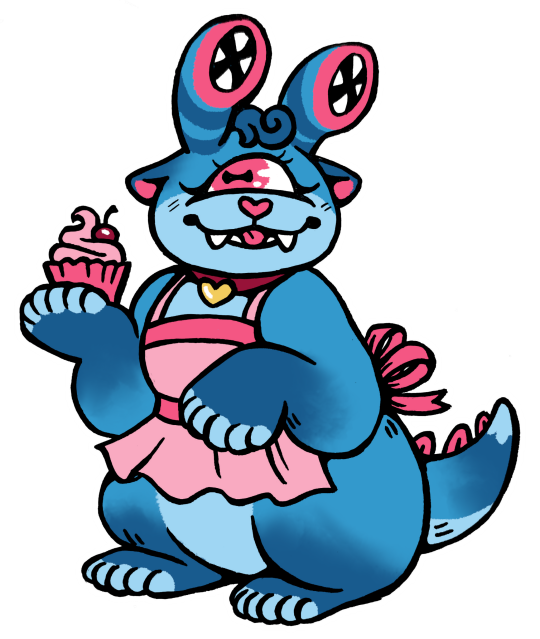
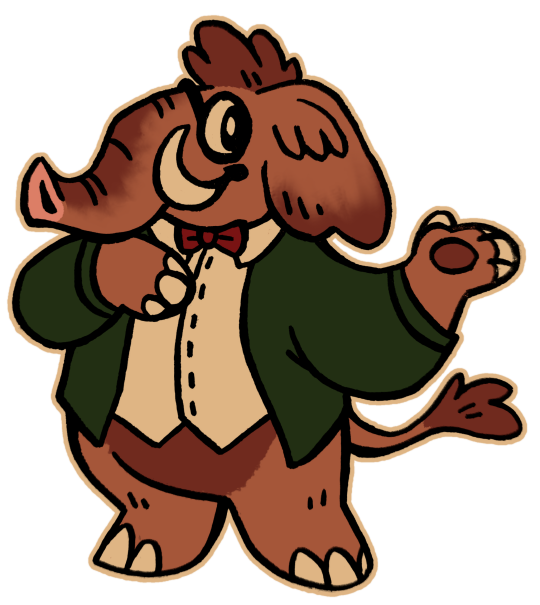

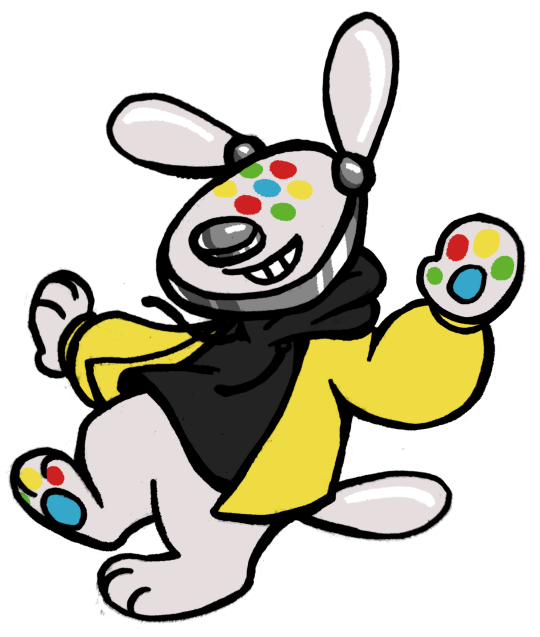
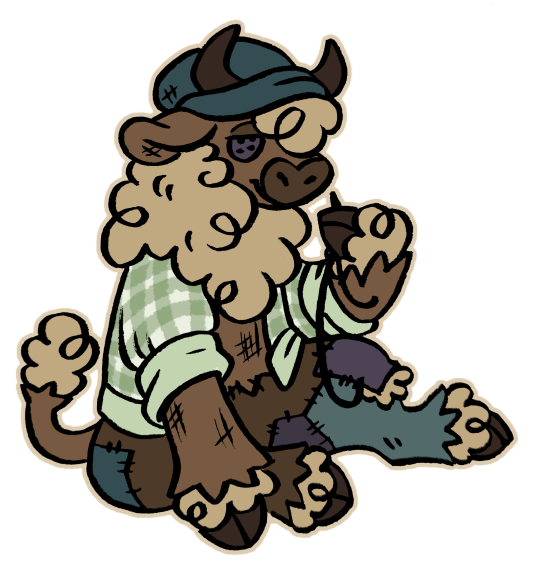



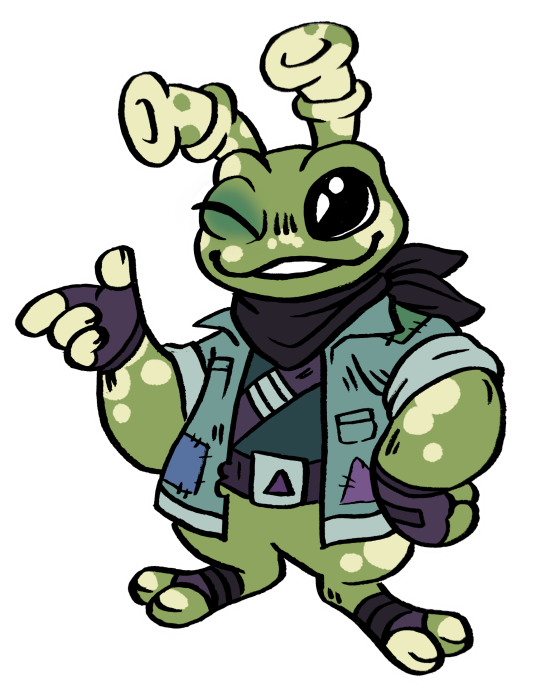
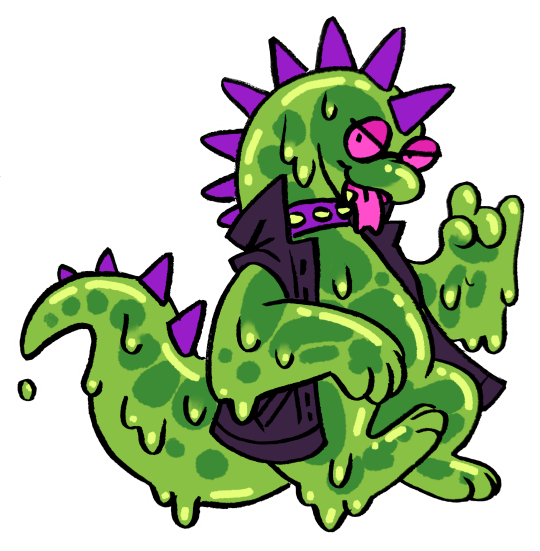
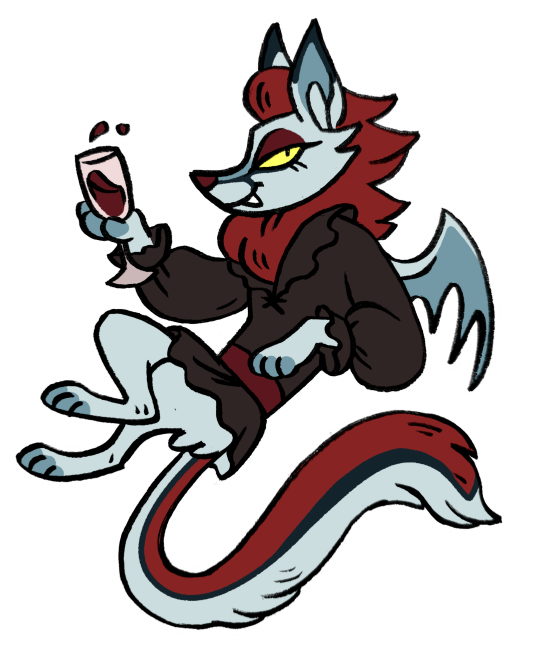
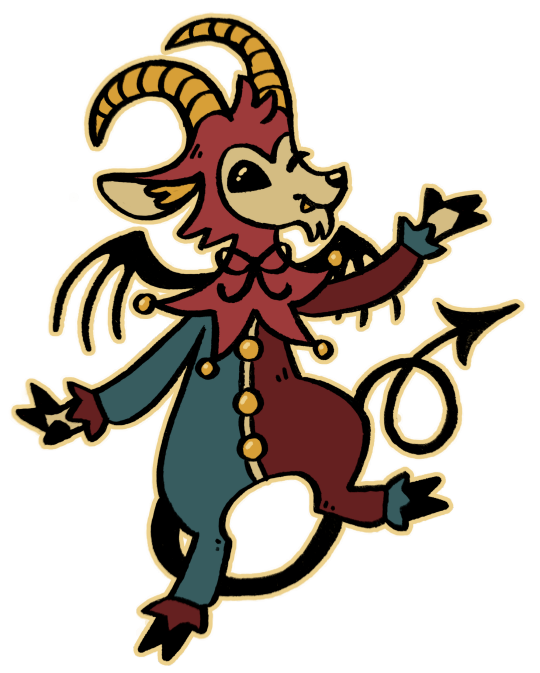
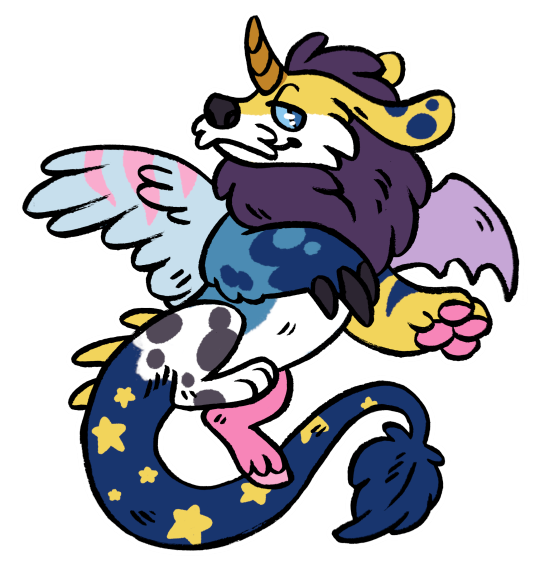


all my beasts! my main account is totally full now rip. names & info under the cut
aske - halloween acara, he/they - horror artist & author, kinda the main character. he writes a horror-comedy comic, but his most famous work is a series of intense horror novels published under a pseudonym. he's secretly a huge scaredy-cat & has become very fond of a certain zafara.
flora - mutant aisha, she/her - baker & activist. she runs a little bakery in the haunted woods that only employs other mutants. she's sweet as sugar, but you don't want to be on her bad side. not afraid of anything- in fact, she has a sweet spot for the scariest resident, alder.
fossil - tyrannian elephante, he/him - anthropologist, museum curator, technically undead. he was found in a glacier on the border between tyrannia and terror mountain & revived. now, he has a special interest in tyrannian history, spending more time in the field than behind a desk. he will talk your ear off.
kilroy - steampunk zafara, he/him - a knight from the golden era of meridell- sort of. he was brought to life via a wayward spell from mac, pulling him from the pages of a book of old meridellian tales. he's a little lost, but taking it in stride- besides, he has a cute lil acara to help him out.
pup - toy poogle, they/she - midi musician, streamer, sapient robot. they speak almost exclusively in internet memes and audio clips. she has a vast collection of expression stickers, one for every mood. recently, they've been visiting veknir's workshop every night…
mu - burlap kau, he/they - fiber artist, gardener, ex-scarecrow. he used to live in a farm north of the haunted woods, then took himself off his stick and ran away. he sewed his legs himself, as he didn't have any originally, and has to fix them often. makes a lot of crochet plushies and blankets- stark contrast to the manor's otherwise spooky vibe.
alder - shadow skeith, she/her - groundskeeper. an intense individual, to say the least. she's been with the manor longer than anyone can recall. she mostly keeps to herself- she lives in a small cabin on the edge of the courtyard. she spends her time meticulously cleaning the tombstones, or lurking in the yard in the midst of heavy rain. aske is terrified of her.
rory - chocolate/halloween bori, he/it - some variety of candy-based creature. he only joined the group recently- previously he was known as the thing that howls and roars just past the fence line. he smells like candy corn and hot cocoa- apart from the bones, of course. those smell like death.
maxie - ghost cybunny, she/her - tour guide/scam artist. she offers tours of the manor, even installing a little gift shop in the foyer. most of the 'haunted features' on the tour are fake. even if the others wanted her to leave (frankly, she's a rude, self-serving conwoman), she couldn't- she died in the manor. every time someone asks how she died she gives them a different story.
veknir - speckled grundo, he/him - alien, scientist, engineer. he keeps the manor running- repairing old appliances, fixing broken railing. of course, he did blow up the microwave trying to improve it. he crash-landed in the courtyard while fleeing someone and set up a workshop/lab in the basement. who knows what he gets up to down there? do we want to know?
cake - snot chomby, it/its - slime monster. one of veknir's experiments gone awry- well, it made a new creature, but cake's a rebel. it chose its name after coming to life and immediately raiding vek's lab minifridge. it has a massive sweet tooth- flora is its best friend- and takes its sick axe guitar everywhere (it can't play it)
remy - halloween xweetok, he/they/she - the owner of the october house. the oldest resident (besides kilroy, technically?) and also the hottest (according to remy). if he's not ominously swirling a glass of something red in the study, he's at some club doing drag.
diaveli - halloween ixi, she/they/it - some variety of horrid clown thing. her entire existence is dedicated to tormenting aske and causing problems.
chimaera - lab rat, they/them - they have chronic health issues, but visiting the lab ray and changing their body calms their aches. it also leaves them ravenously hungry and pays fairly well. they also "work" at maxie's gift shop. they sometimes play on pup's streams as a guest.
mac - mutant lenny, he/him - wizard. he spends all his time hidden away in his tower, practicing spells or mixing potions. his hermit-like tendencies are partly because he needs privacy for his evil machinations and party due to crippling social anxiety.
croaksby - candy quiggle, he/him - butler, janitor, etc. a long-suffering servant, croaksby has worked for remy for a long, long time. he does actually enjoy his work- if he gets frustrated with a resident, he can always add a touch of poison to their nightly tea/coffee/borovan- not enough to kill them, of course...
147 notes
·
View notes
Text
ITS ALMOST FOSSIL NOVEMBIRB!!!!!
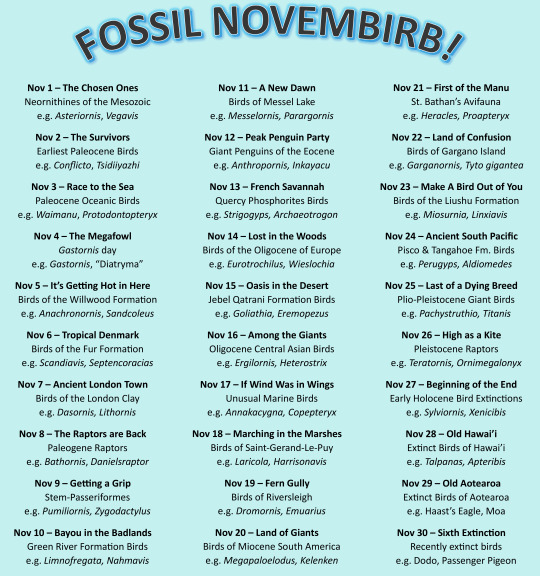
We're going to have a CELEBRATION of FOSSIL NEORNITHINES for this November!!! The extinct members of the only group of dinosaurs we have today!
Each day will have a prompt inspired by the evolution of crown-birds and the amazing forms they have taken over the past 68 million years!
You can respond to each day's prompt however you wish - with drawing and painting, writing, sculpting, music, videos, whatever! Just tag it "#Fossil Novembirb" for me to find it, and it'll get reblogged!
I'm so excited to see the art you guys create!
NOVEMBER 1 - THE CHOSEN ONES
Crown-Birds (Neornithes) known from the Mesozoic Era!
Options include Asteriornis, Teviornis, Vegavis, and "Styginetta"!
These are the only dinosaurs that survived the asteroid!
Theoretically there were also early Palaeognaths and Neoavians - if you want to do some spec evo and hypothesize what you think they might have looked like, go ahead! Follow your dreams!
NOVEMBER 2 - THE SURVIVORS
The earliest birds known after the K-Pg boundary!
Options include Conflicto, Tsidiiyazhi, Australornis, Qinornis, and Qianshanornis!
Birds diverged rapidly after the extinction, so also feel free to dive into spec evo into some of the forms we don't have fossils of!
NOVEMBER 3 - RACE TO THE SEA
The first Marine Neornithines and how they evolved in the early Paleocene!
Includes tons of early penguins like Waimanu, Kumimanu, Sequiwaimanu, Muriwaimanu, and Kupoupou
Also includes the first Pseudo-toothed bird, Protodontopteryx, and the earliest known Tropicbird, Clymenoptilon!
RISE OF THE PENGUINS!
NOVEMBER 4 - THE MEGAFOWL
Gastornis (aka "Diatryma", aka "Zhongyuanus") appeared in the mid-Paleocene and was a feature of the Cenozoic landscape until the end of the Eocene - so we have a whole day JUST FOR IT
Show your love for the Megafowl Gastornis! This giant herbivorous bird was fascinating, and has captured imaginations for decades because of it!
Gastornis is also present in many of the ecosystems described below, such as Willwood, Green River, and Messel, so we also just wanted to make sure people didn't keep picking Gastornis over and over again xD
NOVEMBER 5 - IT'S GETTING HOT IN HERE
The Paleocene-Eocene Thermal Maximum was the most dramatic incident of rapid global warming in the world since the Permian... until today!
It majorly affected the evolution of many things, possibly including birds!
The Willwood Formation straddles the time period of the warming, and has tons of birds that were evolving during that time period! So, for this day, create things involving birds of the Willwood Formation!
Options include the flighted Palaeognaths Lithornis promiscuus and Lithornis plebius; the possible stem-Ostrich Paragrus, the early half-screamer-half-duck Anachronornis, the early owl Primoptynx, and the fascinating stem-mousebird Sandcoleus! And many more!
NOVEMBER 6 - TROPICAL DENMARK
Birds of the Fur Formation, one of the best collections of bird fossils from the early Eocene!
Includes such friends as Scandiavis (an early shorebird), Septencoracias (an early roller), Pellornis (an early rail-esque thing), the utterly mysterious Morsoravis, and the early swift-hummingbird Eocypselus!
This was a tropical shoreline environment with many of the first members of major bird groups we see today!
NOVEMBER 7 - ANCIENT LONDON TOWN
Across the shore from Fur was the London Clay Formation, a lush tropical forest near the warm shallow ocean
In addition to a truly alarming quantity of plant fossils, this is a notable locality for early birds, featuring many early members of major groups much like the Fur Formation
Options include Dasornis (a pseudotoothed bird), Pulchrapollia (one of the Parrot-Passerines of Prey), Nettapterornis (another stem-duck), Nasidytes (an early loon), Charadriisimilis (an early shorebird), Archaeodromus (a trogon-like member of Strisores), Eotrogon (an actual early Trogon), Lithornis vulturinus (another flighted Palaeognath), Prophaethon (another early Tropicbird), and Ypresiglaux (an early owl) - and so many more!
NOVEMBER 8 - THE RAPTORS ARE BACK
Turns out "Predatory Feathered Thing with Really Sharp Foot Claws" is a very successful niche - not only was there potentially one right after the end of the Cretaceous (Qianshanornis), but other raptors were some of the first birds to succeed around the world in the Eocene
So this day is dedicated to the early raptors of the Cenozoic!
Any "raptor" from the Paleogene is valid - so here are some suggestions: Early Cariamiformes (Seriemas and Kin) like Bathornis, Dynamopterus, Strigogyps, and the first potential Terror Birds like Paleopsilopterus Early Owls like Ypresiglaux and Palaeoglaux Early Accipitriformes like Horusornis Early Falcons like Antarctoboenus, Masillaraptor, and Danielsraptor And of course the ever popular "Parrot-Passerines of Prey" like Tynskya and Messelastur
NOVEMBER 9 - GETTING A GRIP
Half of all living birds are Passeriformes - aka "Perching Birds" - but this wasn't always the case! For most of Earth's history, many other kinds of tree birds were extremely common
Where did this behemoth group of tiny dinosaurs come from? That's the subject of this day's prompt!
In the Eocene, the first birds closer to Passeriformes than to Parrots evolved, and they came in a huge variety of forms! So on Nov 9th, we're going to celebrate this group's interesting beginnings!
Options for this include Parapsittacopes, Eofringillirostrum, Pumiliornis, Psittacopes, Zygodactylus, Primozygodactylus, Psittacomimus, Sororavis, Morsoravis, and Eozygodactylus! Go wild!
NOVEMBER 10 - BAYOU IN THE BADLANDS
Back to specific ecosystems! We're visiting the world-famous Fossil Lake of the Green River Formation!
This environment, during the Early Eocene, was a thriving tropical lake and forest ecosystem filled with tons of early Neornithines as well as mammals and other animals
Gorgeous fossils have come out of this lake, showing truly amazing detail of feathers and other features for these birds!
So here you can feature Prefica (a potential early Oilbird), the flighted Palaeognath Calciavis, the stem-turaco Foro, the early mousebird Celericolius, the possible shore-bird Nahmavis, a potential cuckoo roller Plesiocathartes, the Flamingo-Duck Presbyornis, the early landfowl Gallinuloides, the swift-hummingbird Eocypselus, and the Frigate Bird Trying at being a Gull Limnofregata - and so many more!
NOVEMBER 11 - A NEW DAWN
We're finally moving on to the middle Eocene - and the Messel Lake ecosystem, famous from the first episode of Walking with Beasts (hence the name of the day)!
(If you're going "wait, that episode acts like nothing happened between the K-Pg and Messel, but here you have 10 days worth of stuff" .... yeah. Walking With Beasts skipped the Paleocene and early Eocene and I am... very pissed. Still.)
You know about the tons of early mammals from this tropical lake ecosystem, but it was filled with tons of early birds as well!
There's the early ostrich Palaeotis, the crane-rail Messelornis, the almost-flamingo Juncitarsus, the freshwater Booby Masillastega, the early hoopoe Messelirrisor, Selmes (a mouse bird with stubby toes), the early ibis Rhynchaeites, the early nightbird Hassiavis, the early swift Scaniacypselus, an early roller with known colors Eocoracias, and the early potoo Paraprefica - and many others!
NOVEMBER 12 - PEAK PENGUIN PARTY
As the Eocene continued, penguins achieved true megafaunal status - there were tons of them, they were huge, and they were all over the oceans of the Southern Hemisphere
While penguin diversity never did recover after the Eocene-Oligocene extinction event, this golden age deserves celebration!
Some of these fascinating peak penguins include Palaeeudyptes, Anthropornis, Icadyptes, Inkayacu, Perudyptes, and Kairuku!
NOVEMBER 13 - FRENCH SAVANNAH
As the Eocene began to dry up and cool down, plains grew across the world where the tropical forests once had been
One of the most famous later-Eocene fossil sites for birds is the Quercy Phosphorites location, a French formation with tons of interesting fossil birds!
Here we start to see the early forms of Neornithine Dinosaurs we saw in the Paleocene-Early Eocene diverge and specialize further - often in particularly weird or interesting ways!
So here we have the duck-ish chicken Paraortyx, the secretarybird Pelargopappus, you can also bring back Dynamopterus from earlier, there is the stem-chicken Quercymegapodius as well as stem-parrots like Quercypsitta, the seriema-like Strigogyps, the sandgrouse relative Archaeoganga, Archaeotrogon shows up again, the swift relative Aegialornis, a potential woodpecker relative Sylphornis, and more owls like Palaeoglaux! Lots of cursorial predators in this ecosystem!
NOVEMBER 14 - LOST IN THE WOODS
As the Oligocene dawned, forests did grow back in Europe, though they were now temperate and dry as opposed to the paratropical rainforests of before
This lead to wide diversification of tree-dwelling birds, and so here we will celebrate the birds of the Oligocene of Europe!
We start to really see modern-esque birds at this point, though of course we still have 30 million years of evolution to go!
Here you can feature the early eagle/hawk Aviraptor, the European Hummingbird Eurotrochilus, the seabird relative Rupelornis, the early woodpecker-toucan Rupelramphastoides, the tody Palaeotodus, the proper Passerine Wieslochia, the possible shorebird Turnipax, the mousebird Oligocolius, the hoopoe Laurillardia, and the trogon Primotrogon which we know the colors of!
NOVEMBER 15 - OASIS IN THE DESERT
The Jebel Qatrani Formation of Egypt shows the beginnings of the famous African Grassland animals, as well as many early members of iconic African animal groups such as primates - and, of course, birds!
Taking place in the early Oligocene, this formation was a tropical/subtropical lowland plain filled with ponds and streams and other waterways - aka, tons of swamps surrounded by plains
As such, this place is infested with waterbirds!
Here we have a fossil relative of the Shoebill Goliathia, as well as the jacanas Janipes and Nupharanassa, the giant stork Palaeoephippiorhynchus, the herons Nycticorax and Xenerodiops, and the mystery Palaeognath Eremopezus!
NOVEMBER 16 - AMONG THE GIANTS
Once again we're just fully committing to the Walking With Beasts nostalgia bc these are the birds we wish were in it more okay we said it
Anyways there were some interesting large birds in the plains of the "Land of Giants" episode so picture these guys alongside the Indricothere etc.
In general we're covering the latest Eocene through the Oligocene of Central Asia
Here we have the enigmatic ratites Ergilornis and Sonogrus, the pseudo-toothed bird Caspiodontornis, the owl Heterostrix, and the stem-flamingo Agnopterus
NOVEMBER 17 - IF THE WIND WAS IN OUR WINGS
We all focus on penguins, but over the Cenozoic, plenty of weird birds have evolved for marine life, and boy are they bizarre!
So for Nov 17, we're focusing on the unusual marine birds of the Cenozoic!
This includes any members of the Pelagornithids - aka the Pseudo-toothed birds - as well as the Plotopterids - the Boobies that became Penguins! Pelagornis and Copepteryx are the best known taxa from each, respectively, but there are plenty more!
But that's not all! We have the flightless auks Miomancalla and Mancalla, the large flightless marine duck Chendytes, and who can forget the weird flightless marine swan Annakacygna! Tons of options to choose from!
NOVEMBER 18 - MARCHING IN THE MARSHES
We're now starting our transition from the Paleogene into the Neogene, beginning with the brackish marsh ecosystem preserved at Saint-Gerand-Le-Puy in France!
This Miocene locality preserves a wide variety of birds that are near modern, but not quite - a sort of "uncanny valley" of bird evolution, all set in a somewhat-salty somewhat-not wetland ecosystem
Options for dinosaurs here include Harrisonavis, a transitional flamingo; the early gull/tern Laricola, the enigmatic duck Mionetta, the stork Grallavis, the pratincole Becassius, the swimming-flamingo Palaelodus, the early cormorant Nectornis, the seed-eating pheasant Palaeortyx, the early loon Colymboides, and the mysterious shorebird Elorius!
NOVEMBER 19 - FERN GULLY
Riversleigh is one of the most famous fossil sites in the world, preserving the evolution of the strange and unique animals known today in Australia, during the Oligocene to Miocene transition
Most often, we focus on the bizarre mammals found at Riversleigh, and for good reason - it's a Marsupial Party! - but the birds here are fantastic as well
This ecosystem was a rich rainforest that transitioned over the period of deposition into a semiarid grassland, and covers 20 million years of animal evolution during that transition
Options for birds here include the butcherbird Kurrartapu, the fossil Sittella Daphoenositta trevorworthyi, the Mihirungs ("Demon Ducks") Dromornis and Barawertornis, the Emuwary Emuarius, the early magpie-goose Eoanseranas, the raptor Pengana with flexible ankles, the earliest known species of lyrebird (Menura tyawanoides), the corvid-like Corvitalusoides, the first known cockatoos, the flightless rail-like bird Australlus, the stiff-tailed duck Pinpanetta, the early logrunner Orthonyx kaldowinyeri, and so many more!
NOVEMBER 20 - LAND OF GIANTS
Y'all were probably wondering when we'd get to the Terror Birds and other interesting dinosaurs of South America, so - here we are!
South America, isolated from the rest of the world until the Great American Interchange, featured a wide variety of bizarre and unique animals - not just mammals, but birds and other reptiles as well!
So for Nov 20th, we're looking at the interesting dinosaurs of the "lost continent" during the Miocene epoch, prior to the invasion of North American taxa!
Any Miocene South American Terror Bird (Phorusrachid) is fair game here, so that includes Brontornis, Patagorhacos, Paraphysornis, Devincenzia, Kelenken, Phorusrhacos, Patagornis, Andalgalornis, Psilopterus, Mesembriornis, and Procariama! Note that they did not all live at the same time or even close to each other in location, so do your research on the taxa you pick!
But Terror Birds weren't the only strange dinosaurs in South America at the time! We have the large Teratorn (vulture-like-thing) Argentavis, the *giant* swimming-flamingo Megapaloelodus, the giant Anhinga Macranhinga, the rhea Opisthodactylus, the penguins Palaeospheniscus, Arthrodytes, and Paraptenodytes, the Cathartid Dryornis, the Jacamar Galbula hylochoreutes, fossil Hoatzins like Hoazinavis and Hoazinoides, the giant stork Leptoptilos patagonicus, and the owl Yarquen!
NOVEMBER 21 - FIRST OF THE MANU
Aotearoa has one of the most unique avifaunas in the world today, and I often call it "Mesozoic 2" because of its almost entirely dinosaur-dominated fauna, especially in the past
All great things have to start somewhere or when, and for Aotearoa, that somewhen was after the landmass resurfaced from the ocean for the first time in millions of years - and was quickly inhabited by all kinds of birds and other reptiles (including tuatara) in the Miocene
This ecosystem was a lake bordered by grassy wetland floodplains and subtropical forests, a bit warmer than Aotearoa today
Dinosaurs here include the early Kiwi Proapteryx, an unnamed early Moa, a truly alarming number of waterfowl including shelducks like Miotadorna, stiff-tailed ducks like Manuherikia, and the possible swan Notochen, the small swimming-flamingo Palaelodus aotearoa, pigeons like Rupephaps and Deliaphaps, an early adzebill Aptornis proasciarostratus, flightless rails like Priscaweka, the lake-wanderer Hakawai melvillei, the herons Pikaihao and Matuku, the giant parrot Heracles, proto-keas Nelepsittacus, and the New Zealand Wren Kuiornis. Tons of fun species to choose from!
NOVEMBER 22 - LAND OF CONFUSION
In the Late Miocene to Early Pliocene, the Italian province of Gargano was cut off from the mainland due to rising sea levels, turning it into an island - an island with lots of really strange birds!
This island was cut off from everything else and completely lacked large predators, allowing for a weird variety of animals to evolve and thrive prior to the island rejoining the mainland during the Ice Age
Strange birds of this ecosystem include the extremely old pigeon Columba omnisanctorum, the giant hawk Garganoaetus, the giant flightless goose Garganornis, the giant barn owl Tyto gigantea, the pheasant Palaeortyx volans, and the swift Apus wetmorei!
NOVEMBER 23 - MAKE A BIRD OUT OF YOU
The iconic animals of the Ice Age and recent prehistory had to come from somewhere, and much of this transition is recorded in the Chinese Ecosystem of the Liushu Formation, deposited between 11 and 6.4 million years ago
As grasslands expanded, this ecosystem transitioned from a forest to a wide plains, and many animals adapted for the grasslands accordingly, leading to the appearance of such mammals as Elasmotheriines, Sabercats, Hyenas, Ambelodonts, and a truly alarming quantity of hoofed mammals
Dinosaurs (Birds) adapted to this ecosystem change as well, of course! While most focus on the mammals of Liushu, we're here to showcase the interesting birds that appeared here as well!
Options here include the the very well preserved Falcon Falco hezhengensis, the vultures Mioneophron and Gansugyps, the diurnal owl Miosurnia, the vocally fancy pheasant Panraogallus, the sandgrouse Linxiavis, the Ostrich Struthio (or Orientornis) linxiaensis, and the probable-Ostrich Sinoergilornis
NOVEMBER 24 - ANCIENT SOUTH PACIFIC
Penguins are Bouncing Back! As the Miocene continued and the Pliocene began, many new types of marine birds showed up and were fossilized in locations in Chile (Pisco) and Aotearoa (Tangahoe)
Tons of interesting birds were preserved in this sort of transitional ecosystem, showcasing how birds adapted to changing conditions as the Miocene-Pliocene climatic turmoil continued
These near shore environments are probably more famous for their other animals - things like the giant shark "megalodon", as well as weird whales like Livyatan and Odobenocetops and aquatic giant sloths (like Thalassocnus) and marine crocodilians - but we're here for those dinosaurs!
Options here from the Pisco Formation include the "Toucan-Booby" Ramphastosula, the Cathartid Perugyps, the Booby Sula figueroae, Pelagornithids, Pelicans, and the penguins Spheniscus urbinai and Spheniscus megaramphus, whereas birds from the Tangahoe Formation include the narrow-beaked albatross Aldiomedes, the giant petrel Macronectes, the more regular-sized petrel Procellaria altirostris, the little penguin Eudyptula wilsonae, and the crested penguin Eudyptes atatu!
NOVEMBER 25 - LAST OF A DYING BREED
We all love Megafuana, even though they are usually the "Live Fast Die Young" kind of species - gobbling up resources and growing too big will do that to you
Usually when we hear the term "Megafauna" we think of Mammals and Non-Avian Dinosaurs, but birds have had their share too - and have lost their share as well
So, mainly to cater to the Megafauna Fanbase, here we dedicate a whole day to the giant birds of recent times - Pliocene through Pleistocene - that we have lost to the dramatic climate change of the Ice Age Era. (Those lost in the Holocene will get their own days, see below)
Options for this day include the giant ostrich Pachystruthio, the Mihirung Genyornis, the Terror Bird Titanis, the giant stork Leptoptilos robustus, the giant swan Cygnus falconeri, the giant Anhinga Giganhinga, and of course - we can't forget our friend - the last of the Pseudotoothed Birds, Pelagornis
NOVEMBER 26 - HIGH AS A KITE
In many ways, the real dinosaur winners of the Ice Age were the flying Birds of Prey, as there were many kinds of raptors during the Ice Age and they exploited the new environment expertly
Nothing like being able to traverse huge distances to find places where there are food, amiright?
So this day is dedicated to the fantastic Raptors of the Ice Age, both volant and not!
Here we have some of the last of the Teratorns like Teratornis itself, the Giant Australian Raptor Dynatoaetus, the Australian Vulture Cryptogyps, Woodward's Eagle Buteogallus woodwardi, the tiny Condor Wingegyps, the large Cuban Eagle Gigantohierax, the wandering vulture Neogyps, the Walking Eagle Buteogallus daggetti, the Giant Cuban Stilt-Owl Ornimegalonyx, and one of the last Terror Birds, Psilopterus
NOVEMBER 27 - BEGINNING OF THE END
Oh Holocene Extinctions. As upsetting as they are, they include some of the best known fossil/subfossil birds, so we decided to spend a little extra time on them than they should have based solely on the time length
Here, we highlight the early losses of the Holocene - those dinosaurs that went extinct at the start, largely due to direct human activity such as hunting in addition to the warming caused by the end of the last Ice Age/Glacial Maximum
Days will be dedicated to both Hawai'i (see below) and Aotearoa (again, below), so this is for everyone else!
So options here include the previously mentioned marine duck Chendytes, the giant flightless landfowl Sylviornis from New Caledonia, the famous Elephant Birds of Madagascar, the flightless clubbing-ibis Xenicibis, the weird puffin Fratercula dowi, the giant Bahama Eagle Titanohierax, the Californian Turkey Meleagris californica, and the flightless "Cave Rail" Nesotrochis of the Greater Antilles
NOVEMBER 28 - OLD HAWAI'I
Many, many, MANY unique dinosaurs live on islands. The islands of Hawai'i are no exception, and these islands have lost many unique and fascinating birds over the years - thanks to human activity, invasive cats, colonialism, and climate change
We couldn't possibly ignore them, so for this day, we are hilghlighting these amazing animals found across the archipelago
There are tons of options, but some of our recommendations include the reverse-platypus/Mole Duck Talpanas, the Stilt-Owl Grallistrix, the flightless ibis Apteribis, the Moa-Nalo like Chelychelynechen, Ptaiochen, and Thambetochen, the Wood Harrier Circus dossenus, Hawai'ian Honeycreepers like Drepanis, Aidemedia, Hemignathus, Chloridops, Akialoa, Rhodacanthis, Dysmorodrepanis, Telespiza, and Vangulifer, the Oloma'o and ʻĀmaui thrushes, ʻōʻō's/Hawai'ian Honeyeaters like the Kioea, Kauaʻi ʻōʻō, and Oʻahu ʻōʻō, the giant Hawai'i Goose, the nēnē-nui/wood-walking goose, the Robust Crow, the flightless Laysan Rail, and the O'ahu Petrel
NOVEMBER 29 - OLD AOTEAROA
We're finally here: Pre-Human Holocene Aotearoa, aka Mesozoic 2, aka The Land Where Mammals Ain't Shit
I love Aotearoa so much. Why wasn't I born there. The universe isn't fair.
The ecosystems were very similar to today - podocarp forests and southern beech forests, grass and tussock plains and shrublands, and plenty of coastal habitats, all usually temperate in terms of climate
All named Moa are fair game. All of them, all named members of Dinornithiformes. So the North Island Giant Moa, the South Island Giant Moa, the Bush Moa, the Eastern Moa, the Broad-Billed Moa, the Heavy-Footed Moa, Mantell's Moa, the Crested Moa, and the Upload Moa. Follow your Moa-Filled Dreams!
Obviously there were more than Moa - not just the living species of Aotearoa still with us, but tons of other extinct forms for Fossil Novembirb. This includes the Adzebills, Haast's Eagle (of course), the whēkau/Laughing Owl Ninox albifacies, the New Zealand Goose Cnemiornis, the New Zealand Owlet-Nightjar, the mehonui Diaphorapteryx, the Long-Billed Wren Dendroscansor, the piopio Turnagra, and the Huia
NOVEMBER 30 - SIXTH EXTINCTION
And, for our last day, we cover recent Holocene extinctions (not on Hawai'i or Aotearoa) - the birds/dinosaurs we have lost in the living past, due largely to colonialism, capitalism, globalism, and climate change
Any bird extinct since 1492 not previously covered is fair game, and there are a lot of them. Today, we honor them, however we can.
Some suggestions include the Dodo (of course), the Cuban Macaw, the Pink-Headed Duck, the Northern Curlew, the Great Auk, the Passenger Pigeon, the Carolina Parakeet, the Ivory-Billed Woodpecker, the Labrador Duck, the Saint Helena Hoopoe, and the Spectacled Cormorant; though there are of course many otherse to choose from as well
Kind of a bummer note to end on, but here we are
Living Birds already get tons of time and attention, so we really don't want to include them here - we love them, but the fossils of the Neornithes world deserve love too! So we tried to cover all of the bases, as best as we could!
Remember, Wikipedia, the Paleobiology Database, The Works of Gerald Mayr, the third volume of "Earth Before Us", and the blogs of myself and @albertonykus and @otussketching are all fantastic resources to look for information about these wonderful animals! Also check out Through Time and Clades' "Dinosaurs: The Second Chapter" series and the Raptormaniacs blog from Albert as well!
HAVE FUN! CREATE WHAT YOU DREAM! AND LOVE CENOZOIC DINOSAURS!
HAPPY FOSSIL NOVEMBIRB!
#Fossil Novembirb#Novembirb#Dinovember#birblr#palaeoblr#Birds#Dinosaurs#Cenozoic Birds#Neornithines#Dinovembirb
611 notes
·
View notes
Text





WHEW I FINALLY GOT THIS DONE
I really wanted to get the lore on the dragons of Evros, because well one, I fucking love dragons, and two, the latest iteration of my dragon lore is very outdated.
Anyway! Lore stuff under the cut because it’s very long…
Anatomy
The dragons of Evros are not like the common depiction seen in modern tales, with four legs and additional wings. They’re more serpentine in shape with only two limbs. And they also lack the firebreathing of most modern dragons, too…
1: The dragon clade is defined by the atter sac found near their stomach. As it’s a soft organ, this makes figuring out the fossil history of dragons a painful headache. This organ is actually a modified gall bladder, and while it still aids in digestion, the fluid it produces has another use. When the dragon is threatened, it expels the fluid from its gall, and breathes it out as a corrosive gas that melts flesh. Oddly enough, the corrosion doesn’t affect plant matter much, but it does affect metal.
2: Dragons have a pair of fins at their head for display, communication, and processing sound. Their horns are in pairs of four, while usually short some dragons prefer to grow them longer.
3: A real trait of many reptile species is the parietal eye, a sort of simplistic third eye at the top of their head. In dragons, this eye is much more complicated, and able to see in the same way as their other two eyes.
4: At the end of a dragon’s body of their tail spade. Tbh I put this here to fill space
5: Like birds and bats, dragons have evolved flight with arms modified into wings. These wings are different from other vertebrate wings however, in that the arm itself is not changed from a regular leg, instead their wings are formed from a fishlike fin attached to the arms. The fins are surprisingly strong and resistant to damage, but by themselves they would just be able to glide. Owing to the magical nature of dragons, they can actually fly. They’re also helpful for swimming, and the claws are good at digging, making dragons true jacks of all trades. (fin wings are based off of Tyrantisterror’s dragons, Midgaheim influenced a lot when it comes to dragons tbh)
Life Cycle
1: As typical of squamates, dragon eggs are soft-shelled. Their delicate nature means they must be guarded at all times, usually by tag team. To break out of their eggs, the hatchlings have an egg tooth (though sometimes they poke their tail spade out first) which they never shed.
2: Baby dragons are hardly recognizable as such, looking more like odd looking snakes. They stay with their parents at all times when very young, but soon will gain the independence to be on their own.
3: Dragonets eventually grow a pair of front legs, though at first they’re small spikes. This is the signal for brumation to begin. The dragonet will dig a burrow for itself, then must eat as much as possible to prepare for their long sleep.
4: Growing a limb is a strenuous process, so going into slumber eases it. The dragon’s legs and wings will grow while buried, and once satisfactorily formed, the dragon’s internal clock will ring and wake them, now with wings ready to fly.
Culture
Like many other organisms touched by magic, dragons are sophonts able to think and communicate on complex levels.
1: The wyrms of Evros are split into three separate ecotypes depending on habitat. The sea dragons or leviathans are the largest of them, with the sea allowing more space to grow than the land. The swamp dragons or knuckers are the smallest, so it’s easier for them to sneak through their forests. The river dragons or wyverns are in the middle regarding size, but have the biggest wings and are the best fliers, a helpful trait in their mountain habitats.
2: An odd behavior of dragons is their tendency to collect objects for a hoard. These hoards are less a random assortment of junk and more complex art pieces. Rocks are arranged in one area while bones are arranged in another. Despite common claims, dragons don’t really prefer precious stones over any other group of curiosities, leaving many an avaricious dragonslayer or their quest giver disappointed. Sea dragons don’t have hoards in the typical sense, instead considering the barnacles and algae and other symbiotes growing upon their body as their hoard.
3: Sea dragons are nomads, same as most oceanic creatures (except when raising their children, which live on land until finishing metamorphosis), but their more terrestrial kin have shelters. River dragons live in mountain caves as close to a river as possible, ideally there when they arrive but sometimes they have to dig them out themselves to avoid fights over territory. There aren’t many caves around swamps, however, so swamp dragons have to build their own homes. With dead or dying trees and a bit of mud, these dens are surprisingly sturdy. While river dragons are more territorial, swamp dragon dens often include small groups of dragons that live in the same territory, albeit with their own chambers. (swamp dragon den concept taken from this post)
4: Like many other reptiles, dragons are semi-social. They don’t need social bonding, nor do they shun it. Between the ecotypes, swamp dragons tend to be the most sociable, as mentioned living in communal dens, while river dragons are the least, only allowing family, old friends, mates, and those unaware of the boundaries to enter their territories. Also like other reptiles, dragons are great parents, taking care of their children while they’re still vulnerable. They even care for dragonets that aren’t their own, even river dragons refuse to attack youngsters if they cross territorial boundaries. The young are left to fend for themselves once they’ve gone through metamorphosis, but by then they’ll most likely be ready to survive on their own. If a death does happen though, the dragon’s kin and companions will surround their body to mourn them, and each will devour part of their flesh so the deceased can stay with them, and the rest of the body is left to feed the scavengers and the plants.
5: The draconic gods are not avatars or lords of their respective domain, they are the domains personified. The trio of Ocean, Sky, and Earth form the Divine Cycle. Ocean bleeds evaporation to feed Sky, Sky bleeds rain to feed Earth, Earth bleeds rivers to feed Ocean. Life itself echoes this cycle, with the plants feeding the grazer, the grazer feeding the hunter, and the hunter feeding the plants. This religion has several variations, but the Divine Cycle is always a key component.
Chimeras
While this informational only focuses on the wyrms of Evros, they are not the only dragons of the world. In fact, there are several species of dragons beyond the seas of Evros, such as the luong of Tianxia. The discussion of these dragons is best for another time, or other people. Regardless, we still shall discuss other dragon species, specifically draconic chimeras.
Velue: A hybrid of wyrm and tarantula. They’re deadly to both prey and predator, with venom that has a similar effect as frostbite and stinging hairs upon their body. Most of the time monsters are killed for their body parts, so with organ harvesting being made difficult with their hairs stinging, there seems to be no reason for the velue to be slain. But with the kingdom’s propaganda against monsters, especially reptiles and arthropods, they are slaughtered anyway, their bodies left to rot.
Carcohl: A hybrid of wyrm and snail. They live around hydrothermal vents. Their scales are highly sought after due to their exceptional toughness, so they’re commonly targeted by knights. Strangely enough, they aren’t the only snail-dragon chimeras in the world, that nature being shared with the Shusshebora.
Hydra: A hybrid of wyrm and hydra, which gets laterally confusing when specifying that hydras are a type of cnidarian. The dragons can regrow their heads if cut off, using their toxic blood to keep an attacker from further pursuit. While mainly dwelling in the ocean, the most famous member of this species lived in the lake of Lerna.
Pyrausta: A hybrid of wyrm and pyrallis, a magical moth. Like the pyrallis, the pyrausta has resistance and power of fire. With this and its body plan of four legs plus a pair of wings, this makes these little moth dragons the closest equivalent to the typical modern dragon in Evros.
Dracosaur: A hybrid of wyrm and primitive bird. It seems the bird that the dracosaur owes part of its genome from has gone extinct. They’re based on the art of dragons with bird wings from medieval bestiaries. I don’t have much on them sorry :(
#artists on tumblr#dragons#fantasy#spec bio#worldbuilding#monsters of evros#wyvere draws#cw: animal death mention#cw: cannibalism#ask to tag
33 notes
·
View notes
Photo

RARE Miocene Ray Tooth Fossil | S'Algar, Menorca | Authentic Prehistoric Marine Specimen | Certified Fossil | Collectible Fossilized Tooth
Discover a Rare Ray Tooth Fossil from the Miocene epoch, unearthed in S'Algar, Menorca. This beautifully preserved fossil offers a glimpse into the marine life that thrived around 15 million years ago. Menorca’s fossil-rich formations provide some of the finest examples of prehistoric marine life, making this an exceptional addition to any fossil collection.
Rays, known for their cartilaginous skeletons and specialized dental plates, used their teeth to crush and grind shellfish and crustaceans. This rare specimen highlights the intricate details of the tooth structure, making it a valuable educational and display piece.
Fossil Information:
Species: Prehistoric Ray (Exact species undetermined)
Fossil Type: Single Tooth
Geological Formation: Miocene Deposits
Age: ~15 million years old (Miocene Epoch)
Location: S'Algar, Menorca
Size: Full sizing provided in photos (Scale: 1cm per square)
Preservation: Excellent, showing distinct dental features
Key Features:
✔ Authentic Miocene Ray Tooth Fossil
✔ Sourced from the fossil-rich region of Menorca
✔ Well-preserved with natural dental structures
✔ Ideal for collectors, museum displays, and educational use
Authenticity & Certification:
All of our fossils are 100% genuine specimens and come with a Certificate of Authenticity. The fossil shown in the photos is the exact specimen you will receive.
Why Buy From Us?
This Ray Tooth fossil comes from the prestigious Alice Purnell Collection, one of the largest and most respected fossil collections in the world. We specialize in high-quality, museum-grade fossils, ideal for serious collectors, educators, and researchers.
🦈 Own a rare piece of Miocene marine history today—add this Ray Tooth fossil to your collection!
#Ray Tooth Fossil#Miocene Fossil#Menorca Fossil#Prehistoric Marine Fossil#Fossilized Ray Tooth#Certified Fossil#Authentic Fossil#Fossil Collector Item#Marine Life Fossil#Fossil Tooth Collection#Fossil from Spain#Fossil Gift#Rare Fossils for Sale#Shark and Ray Fossils#Miocene Marine Fossil
0 notes
Text





As a present for our wedding anniversary this year, my wife got me this AMAZING fossilized Megalodon tooth! This stunning collector quality specimen was recently found in 40 feet of water off the coast of Savannah, GA. Ocean elements and feeding damage created unique chips, markings, and color to this originally white tooth, and the enamel and root are still intact. Even the serrations remain super sharp 3-5 million years later! 🦈
Megalodon was a biological marvel, dominating the oceans for more than 20 million years. Reaching sizes upwards of 50 feet in length, the largest jaw reconstruction of the behemoth measures 11 feet across and over 9 feet tall! The now-extinct shark had teeth up to 7 inches long as well as the strongest bite force of any animal in history at more than 40,000 PSI. To put that into comparison, the strongest today is the saltwater crocodile at just 3,700 PSI!
#collecting#collection#collectibles#collector#shark#sharks#shark tooth#megalodon#fossil#fossils#genuine specimen#fossil specimen#tooth#prehistoric#anniversary gifts#prehistoric animals#paleontology#jaws#shark teeth
4 notes
·
View notes
Text






My fossil collection. Tyrannosaurus rex tooth replica, juvenile Spinosaurus tooth (real fossil, my prized possession), Allosaurus claw replica, Megalodon tooth (real fossil), a pair of fish fossils (not sure on the species).
#red squeaks#fossils#tyrannosaurus rex#spinosaurus#allosaurus#megalodon#fish#vulture culture#paleoblr
29 notes
·
View notes
Text
Round 2 - Chordata - Petromyzontida




(Sources - 1, 2, 3, 4)
Petromyzontida is a class comprising one order, Petromyzontiformes, commonly called “lampreys.”
Like their closest living relatives, the hagfish, lampreys bear a cartilaginous skull and rudimentary vertebrae. Adults lack a jaw, and are characterized by a toothed, funnel-like, sucking mouth. They have elongated, eel-like bodies reaching up to 1.3 metres (3.9 ft) long. They have one nostril atop the head, seven gill pores on each side of the head, two well-developed eyes, and two parietal eyes. Only 18 species are predators or scavengers, the rest (all freshwater species) do not feed as adults, instead living off the reserves gained as juveniles. Carnivorous species are marine, though 9 of them migrate into freshwater to breed. They use the suction cup around their mouths to cling to rocks or prey, using their tongue to either rasp blood from prey or algae from rocks. They also use this suction cup to climb up rocks when migrating upstream to breed.
Adult lampreys spawn in nests of sand, gravel and pebbles in clear streams. After hatching from their eggs the larvae, called ammocoetes, will drift downstream with the current until they reach soft and fine sediment in which to burrow, taking up an existence as filter feeders, collecting detritus, algae, and microorganisms (image 4). Their eyes are underdeveloped, only capable of discriminating changes in light. Lampreys spend the majority of their lives as these filter-feeding ammocoetes. Most species spend up to 8 years, though some may spend as little as 1-2 years. The ammocoetes will then undergo a metamorphosis which generally lasts 3-4 months, during which they do not eat.
The oldest fossil lamprey, Priscomyzon, is known from the Late Devonian. Other stem-group lampreys, like Pipiscius, Mayomyzon and Hardistiella are known from the Carboniferous. While they appear relatively unchanged, stem-lampreys lack the specialised, heavily toothed discs with plate-like laminae present in modern lampreys, and their larvae resembled the adults, rather than having a distinct stage. The earliest lamprey with the specialised toothed oral disc typical of modern lampreys is Yanliaomyzon from the Middle Jurassic.

Propaganda under the cut:
Many species change color as ammocoetes, becoming dark during the day and pale at night.
Lampreys have been extensively studied because their relatively simple brain is thought to reflect the brain structure of early vertebrate ancestors, thus providing insight into our origins.
Lampreys are valued as food in the Northwest United States, throughout Europe, in Russia, Japan, and in South Korea. King Henry I of England is claimed to have been so fond of lampreys that he often ate them, late into life and poor health, against the advice of his physician concerning their richness, and is said to have died from eating "a surfeit of lampreys".
In the county of Nakkila (Finland) and Carnikava Municipality (Latvia), the European River Lamprey (Lampetra fluviatilis) is the local symbol, found on their coats of arms.
The legend of the Lambton Worm from County Durham in North-East England concerns a lamprey being fished out of the River Wear by a young boy skipping church. He declares that he had “caught the devil” and disposes of it down a nearby well. Over the years, the lamprey grows into a giant, poisonous Worm, wrapping itself around a local hill and terrorizing the village. Hijinks and witch-curses ensue.
Lampreys were highly appreciated by the Ancient Romans, not only as food, but also as pets. Lucius Licinius Crassus was mocked by Gnaeus Domitius Ahenobarbus for weeping over the death of his pet lamprey, who he was said to have adorned with earrings and small necklaces, training it to respond to its name and swimming up to eat what was offered. Crassus retorted that Domitius had lost three wives himself and Crassus had never seen him shed a tear.
Publius Vedius Pollio was reportedly an exceedingly cruel Roman soldier who kept a pool of carnivorous lampreys to which he would feed slaves who had displeased him. This went on until Gaius Julius Caesar Augustus was visiting his mansion and witnessed Pollio about to dispatch a slave who had broken a crystal cup. Augustus had all of Pollio’s cups destroyed, as well as his mansion, and filled in his pond. This is likely an urban legend, but honestly, I feel like it should have ended with Pollio going down with the lampreys.
Dams and other human development have made it hard for lampreys to migrate upstream to breed. Some scientists are hoping to design ramps that will utilize lamprey’s climbing ability so that they can bypass dams.
#idk where the gif comes from so I’m sorry if it’s from something Problematic™#round 2#animal polls#chordata#petromyzontida
82 notes
·
View notes
Text




I finished more of these absolute miniscule curio collection pendants! I try to fit as many tiny interesting items into each of these pendants as I possibly can. Some of the possible contents:
Snake bones
Rodent bones
Emu eggshell pieces
Sea shells
Sea urchin spines or pieces of urchin test
Ancient Egyptian beads
Preserved sea weed
Jewel beetle shell pieces
Microfossils
Japanese star sand
Barnacle feeding limb shells
Horseshoe crab claw
Cicada wing or shell limb
Shark tooth fossil
Bryozoan fossil
Various rocks/crystals (opal, Garnet, grape agate, chalcopyrite, etc.
And more!
Link in bio if you want one, or message me if you want a different one. Each comes with a list of the contents!
#goblincore#oddities#vulture culture#miniature#tiny things#crowcore#cabinet of curiosities#natural history#curio collection#curio#resin jewelry#resin art#witchy jewelry#witchy things#my art#potion bottles
73 notes
·
View notes